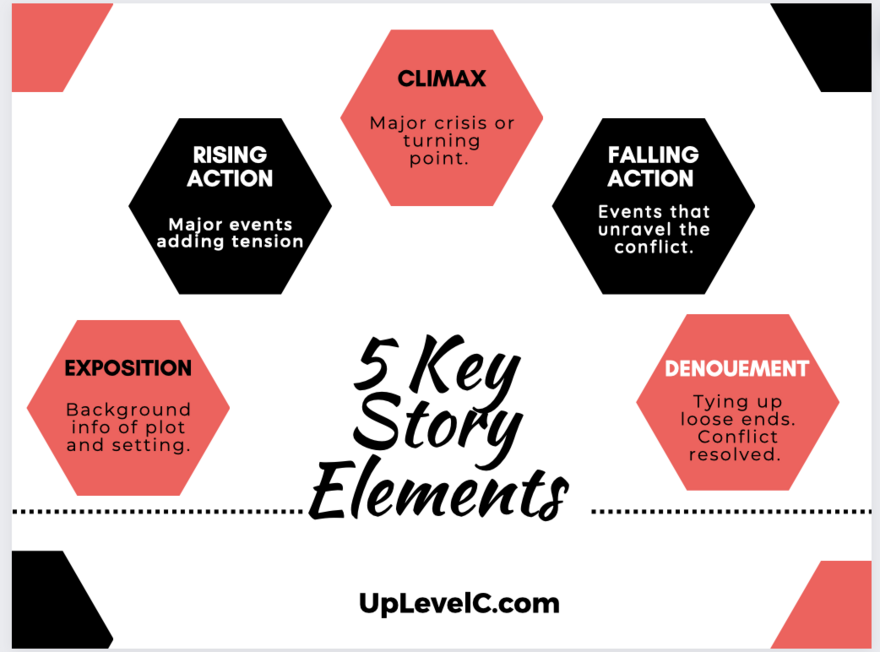5 Key Elements Every Story Needs

In everyday conversation we use the word "story" a lot. You might say to a colleague, "Wow, do I have a story for you!" Or maybe your friend says, "I have to tell you my story about the trip."
But here's the thing...
Sometimes what follows is engaging and interesting. Other times it is a long, drawn-out, wandering trail of words.
If it's engaging, maybe you've been blessed with listening to a natural-born storyteller (there are a few of those out there). But most people could benefit from a little training in their storytelling abilities. And why would you want to become more engaging in conversation?
Because business is all about "know, like and trust." And yes... being likable is part of that equation. If you can tell a compelling story, that's both persuasive and entertaining, you will be more likable. That can lead to more referrals, sales and collaborations. When you're likable, people will want to go the extra mile for you.
Here's how to do it...
Not to take away from the mystique of storytelling but stories do have a formula. If you've ever heard of Joseph Campbell then you know that there's something called the hero's journey. That "formula" for stories is a bit more complex but there's also Freytag's dramatic arc. It's a simpler way to format a story. Using this formula can make content you create and conversations you have more engaging.
And doing so will make you more memorable!
Here are the 5 key elements of Freytag's "dramatic arc" for stories. Try using it in your next networking conversation and see what happens.
1. Exposition:
Where are you in this story? Ever listen to someone start in the middle of a story and you're forced to ask, "wait, where was this?" That's because your brain wants to create the scene. In order to do that, we need a setting. As an example, "once upon a time" is a key indicator that a story is on its way. Our ears perk up and we know when the story is going to take place. Or an example from popular culture (as in the movie, American Pie, "This one time at band camp..." that's a setting! The main character is likely introduced in this stage of the story too. First thing's first, we want to know who exists in the story and where/when this character is located.
2. Rising Action:
What's happening? Typically, this is where the problems show up. With clients who work with us to create animated explainer videos in a story form, this is the section of the story where their ideal client encounters problems. And if you've done any marketing at all, as a business owner, you know one of the major things you identify is your ideal client's problem. What challenges are they facing? Avoid the urge to want to jump in right away with your solutions (a.k.a. your services). There is a time and place for that but it's not here. Stick with their problems first.
3. Climax:
This might come in the form of the worst circumstance your client could face (without you). A climax can be a crisis point. Or, it may simply be the turning point where they decide to do something differently than they've ever done before. Take a bit of time here to describe the emotion and frustration your character is likely feeling. This is relatable to the reader or viewer. If we do it right, this is what makes a story persuasive -- tapping into the emotion.
4. Falling action:
OK business owners, you'll be happy to know we've come to the place in the story where you get to showcase your solutions and services! In this part of the story, your main character (i.e. your ideal client) gets to find your solution and learn a bit about it. Don't worry about listing every possible way under the sun that you can help them. Stick to the main ways you address the pain points that you've previously described. Imagine you've just met this person you're telling your story to... the only goal is for them to want to know more. It's not necessarily the sales pitch clincher you're selling right now.
5. Denouement:
Finally, the conflict you've created in this story up until now has a place to be resolved in this section of the story. And beyond saying "the end" this is the place where you are be able to describe a bit about how your main character's life has improved since they found and implemented your solution. It's like saying, "Once Sally found UpLevel Consulting and created micro learning videos for training and onboarding her team, she found her staff more informed, committed and engaged at work." Oh wow -- a more engaged team... who doesn't want that!?
That's it! Take note and start practicing. As a tip, I'd recommend writing your story out first before you tell it in person. For reference, keep it to around 500 words. You can typically tell a 500 word story in about 3 minutes.
Use your stories as you network and create video content and see how people respond after you start using it consistently for awhile.
If you take on this challenge, please let me know how it works for you! Contact me here and share.
Until then, happy storytelling...in true story-form.

0 comments
Leave a comment
Please log in or register to post a comment